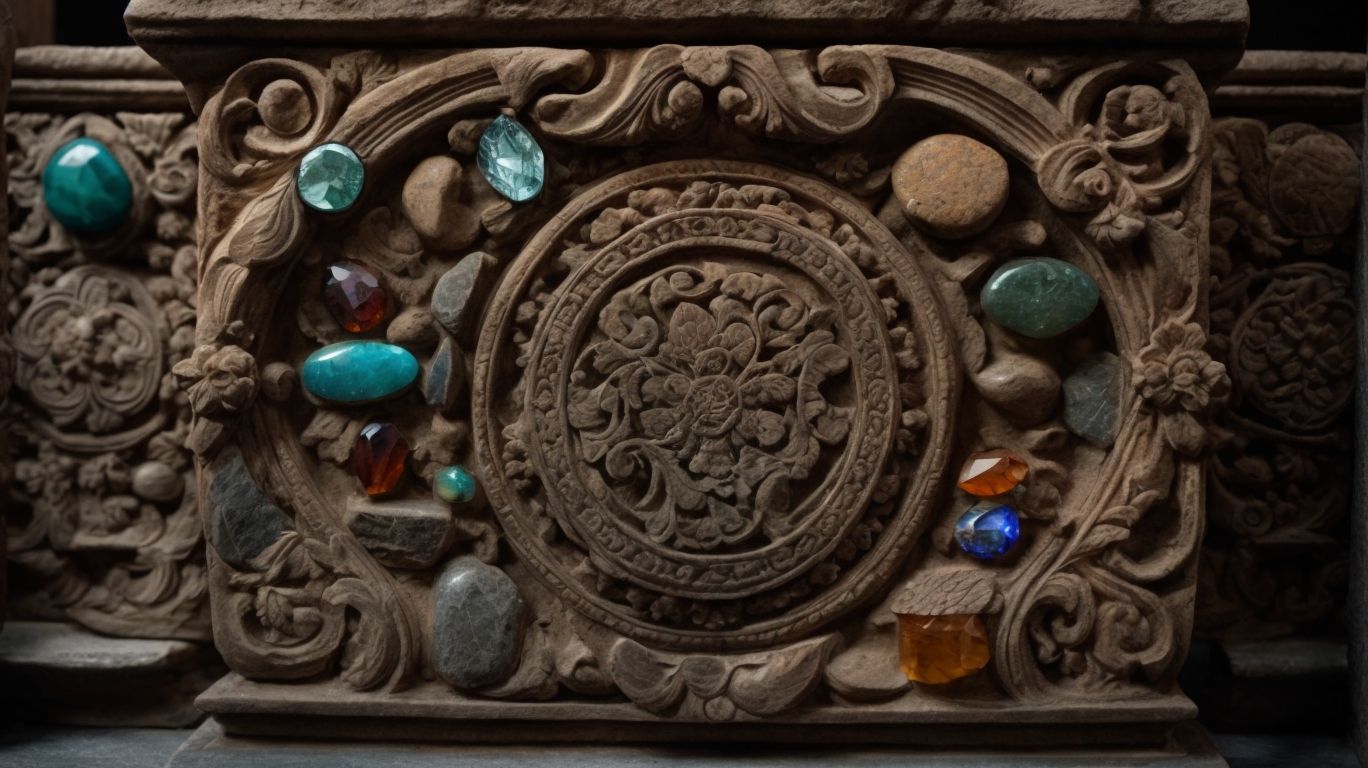
Beliefs Carved in Stone: Understanding Cultural Gemstone Myths
Gemstones have long captured the fascination of civilizations worldwide, with each culture attributing unique meanings and beliefs to these precious stones.
From birthstones symbolizing different qualities to the healing properties associated with certain gems, the myths surrounding gemstones have been deeply ingrained in society.
This article explores the rich history of gemstone myths, delving into how different cultures view these stones and the impact these beliefs have on modern society.
Join us as we uncover the captivating world of gemstone folklore and its influence on our lives today.
What Are Gemstones?
Gemstones are precious stones that hold significance not only for their aesthetic beauty but also for their symbolism, cultural importance, and unique attributes.
They come in a wide array of types such as diamonds, rubies, sapphires, emeralds, and amethysts, each with its own distinct characteristics and meanings. For example, diamonds symbolize purity and strength, while rubies are associated with passion and vitality. In many cultures, gemstones are believed to possess healing properties and bring good luck. From ancient times to the present day, gemstones have been used in jewelry and artifacts to communicate status, protect against negative energies, and enhance overall well-being.
How Have Gemstones Been Used Throughout History?
Gemstones have played a pivotal role throughout history, being revered by ancient civilizations for their cultural significance, embedded within ritualistic practices, and entwined with the fabric of cultural traditions.
What Are the Cultural Myths Surrounding Gemstones?
Cultural myths surrounding gemstones are rich tapestries of legends, traditions, and folklore that infuse these precious stones with symbolic meanings and mystical allure.
Birthstones and their Meanings
Birthstones hold special meanings and mythical powers associated with the months they represent, carrying symbolic significance in various cultures and traditions.
These gemstones have been cherished for centuries not only for their aesthetic beauty but also for their believed abilities to bring luck, protection, and healing properties to the wearers.
People often choose to wear their birthstone as a way to connect with their birth month and tap into the positive energies associated with it. For example, garnet symbolizes love and passion for January-born individuals, while amethyst is believed to bring clarity and inner strength to those born in February.
Each birthstone reflects a unique blend of folklore, history, and spirituality, adding layers of depth to personal adornment and meaningful gift-giving.
Healing Properties of Gemstones
Gemstones are believed to possess healing properties that extend beyond their physical beauty, with metaphysical and spiritual significance attributed to their unique properties.
Throughout history, cultures around the world have revered gemstones for their ability to influence energy flow and promote emotional and physical well-being. In ancient times, civilizations such as the Egyptians, Greeks, and Chinese used gemstones for their healing properties, connecting specific stones to various chakras or energy centers within the body.
Each gemstone is thought to resonate with different aspects of life, from love and abundance to protection and mental clarity. The belief in gemstone metaphysics continues to thrive today, with many individuals incorporating these precious stones into their spiritual practices for holistic healing and balance.
Superstitions and Legends about Gemstones
Superstitions and legends surrounding gemstones reveal captivating tales of mythical creatures and supernatural powers associated with these precious stones.
- Stories dating back centuries speak of dragons guarding treasures of glittering rubies, believing the gemstone possessed the power to grant invincibility.
- In ancient lore, sapphires were thought to protect against envy, while emeralds were said to bestow foresight upon the wearer.
- Diamonds were believed to possess healing properties, capable of bringing clarity to the mind and spirit.
These tales highlight the deep-rooted connections between gemstones and the mystical realms, where each stone’s unique composition was believed to harness different supernatural abilities and offer protection against malevolent forces.
Gemstones in Religion and Spirituality
Gemstones hold profound significance in various religious and spiritual practices, where they are used in rituals to symbolize spiritual connections and convey symbolic meanings.
Throughout history, gemstones have played a pivotal role in ceremonies and traditions, representing purity, wisdom, and enlightenment. These precious stones are believed to possess unique energies that resonate with different chakras or spiritual centers in the body, aiding in healing and balancing one’s spiritual essence.
From ancient civilizations to modern spiritual practitioners, gemstones have been revered for their metaphysical properties and ability to enhance meditation and spiritual growth. Their vibrant colors and properties are often associated with virtues and values that align with different belief systems and cultural practices.
How Do Different Cultures View Gemstones?
Gemstones are viewed differently across various cultures, with each culture infusing these stones with unique cultural beliefs, interpretations, and mythological origins.
Eastern Cultures
Eastern cultures have rich traditions surrounding gemstones, with historical significance attached to these stones and mythical legends woven into their cultural narratives.
From ancient times, gemstones like jade, lapis lazuli, and turquoise have held a special place in Eastern cultures, symbolizing prosperity, protection, and spiritual enlightenment.
In Chinese culture, jade is considered the ‘stone of heaven,’ representing harmony and balance. In Indian culture, gemstones are associated with the nine planets and have been utilized in astrology to balance cosmic energies.
The use of gemstones in Eastern rituals and ceremonies reflects a deep belief in their power to bring luck, ward off evil, and enhance well-being.
Western Cultures
In Western cultures, gemstones are imbued with symbolism and used in ritualistic practices, reflecting mystical beliefs that have been passed down through generations.
From ancient times, gemstones have held a special significance beyond their aesthetic appeal. In Western cultures, these precious stones are often believed to possess unique energies that can influence one’s emotional and spiritual well-being.
For example, diamonds symbolize purity and strength, while amethyst is associated with calmness and clarity of mind. In ritualistic practices, gemstones are often used to channel specific energies or intentions, such as promoting love or protection.
The belief in the mystical properties of gemstones continues to play a significant role in Western cultural contexts, enriching traditions and ceremonies.
Indigenous Cultures
Indigenous cultures have rich gemstone mythology, where symbolic customs and ancient traditions are intertwined with the spiritual significance of these precious stones.
Throughout history, gemstones have played a vital role in Indigenous ceremonies and rituals, serving as powerful talismans believed to harness specific energies and protect against negative forces. These cultures often attribute different qualities to various gemstones, with each stone carrying its own unique symbolism and significance.
For instance, turquoise may symbolize connection to the spirit world, while red jasper is associated with strength and courage. The deep-rooted beliefs surrounding gemstones in Indigenous cultures reflect a profound respect for the natural world and the intricate interplay between spiritual and physical realms.
What Are Some Common Gemstone Myths?
Common gemstone myths are woven with mythical tales, cultural interpretations, and symbolic rituals that illuminate the mystical beliefs surrounding these precious stones.
The Curse of the Hope Diamond
The Curse of the Hope Diamond is a legendary tale steeped in gemstone lore and historical myths, captivating generations with its mysterious and tragic legacy.
This infamous gemstone is said to have originated in India, where it was believed to have been plucked from the eye of a Hindu idol and then stolen, igniting the curse that would follow the diamond across continents and through centuries.
Legends speak of rulers who met untimely deaths or suffered great misfortunes after coming into possession of the diamond, fueling the belief in its supernatural powers.
The history of the Hope Diamond intertwines with stories of betrayal, greed, and tragedy, adding to its mystique and allure.
The Mysterious Powers of the Black Onyx
The Black Onyx is shrouded in mystery, with tales of its mysterious powers and ritualistic symbolism that evoke deep symbolic connections in various cultures.
Believed to possess protective energies, the Black Onyx is often associated with grounding and stability, helping to ward off negative energies and promote inner strength. Across different cultural contexts, the Black Onyx carries a rich tapestry of symbolism, from ancient civilizations who believed in its ability to provide guidance from the spiritual realm to modern interpretations that emphasize its capacity to enhance focus and clear vision.
The Legend of the Moonstone’s Healing Properties
The Legend of the Moonstone highlights its renowned healing properties, steeped in spiritual traditions and intertwined with tales of mythical creatures that enhance its mystical allure.
Throughout history, the Moonstone has been revered for its ability to balance energies and promote emotional well-being. In many cultures, it is believed to possess the power of the moon itself, fostering intuition and inner harmony. Legends speak of the Moonstone being associated with beings such as fairies, mermaids, and even werewolves, adding to its intriguing mystique. These mythical connections have perpetuated its status as a symbol of protection and enlightenment in gemstone lore.
The Myth of the Cursed Amethyst
The Myth of the Cursed Amethyst delves into its mythical origins, historical significance, and the cultural values attached to this gemstone that have endured through the ages.
Legends surrounding the Cursed Amethyst suggest that the gemstone was believed to possess supernatural powers, with some cultures attributing it to protection against intoxication. In ancient times, it was often associated with nobility and regality, adorning crowns and royal jewelry. The rich purple hue of amethyst symbolized luxury and status, while its purported ability to calm the mind and promote clarity made it a highly sought-after gem. Across various cultures, the amethyst held different meanings, representing spirituality, wisdom, and tranquility.
How Do Gemstone Myths Affect Society Today?
Gemstone myths continue to wield influence in society today, shaping cultural interpretations and symbolic uses that resonate with individuals and communities.
Influence on Jewelry Trends
Gemstone myths have a profound influence on jewelry trends, driving demand for specific stones and influencing the incorporation of ritualistic practices and historical significance in jewelry designs.
For instance, the mythical association of amethyst with protection and spirituality has led to an increased interest in jewelry featuring this regal purple stone. This has not only impacted the mining of amethyst but has also inspired designers to create pieces that evoke a sense of tranquility and inner strength.
Similarly, the belief in the protective powers of turquoise has influenced the integration of this stone in jewelry worn during important ceremonies as a symbol of strength and good fortune, reflecting centuries-old traditions and cultural beliefs.
Impact on Gemstone Mining and Trade
Gemstone myths play a pivotal role in gemstone mining and trade, preserving cultural heritage and perpetuating the allure of stones associated with mythological creatures and tales.
These myths have been passed down through generations and have shaped the way we perceive and value gemstones. The stories behind these gems add layers of depth and mystery, making them more than just precious stones but symbols of ancient wisdom and power.
Through these myths, the cultural significance of gemstones is elevated, forging connections between the past and the present. As a result, gemstone traditions are not just about commerce but about honoring traditions and keeping ancient beliefs alive in our modern world.
Cultural Appropriation of Gemstone Myths
The cultural appropriation of gemstone myths raises questions about the misuse of mythical powers, spiritual traditions, and ancient beliefs associated with these precious stones.
One of the fundamental issues surrounding the appropriation of gemstone myths is the erosion of the authentic cultural significance tied to these stones. Many cultures have revered specific gemstones for centuries, attributing them with unique powers and spiritual meanings. When these myths are taken out of context or commercialized without proper understanding, it can lead to a dilution of the rich heritage and wisdom that these traditions carry. The misuse of gemstone myths can perpetuate harmful stereotypes or misconceptions about certain cultures and their sacred beliefs, undermining the respect and reverence that should be given to such practices.




No Comments